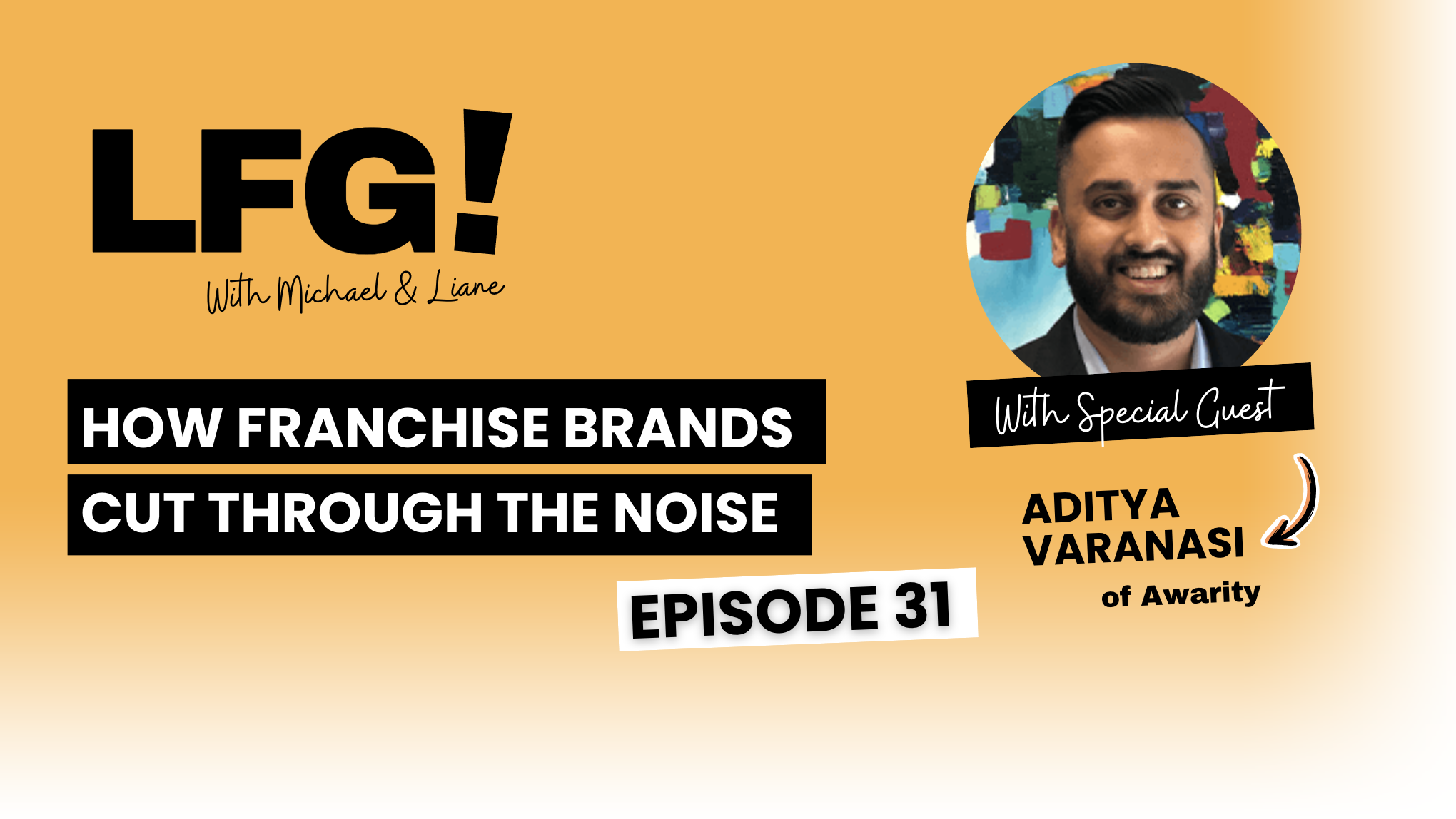E31: How Brands Cut Through The Noise! With Aditya Varanasi

Hosts: Michael Hyam and Liane Caruso
Guests: Aditya Varanasi, Founder & CEO of Awarity
On the LFG podcast, Aditya Varanasi, founder and CEO of Awarity, shared valuable insights about how brands cut through the noise and use revolutionary advertising for small businesses and franchises.
Drawing from his 14 years at PepsiCo and his entrepreneurial journey, Varanasi revealed how AI-powered advertising platforms are democratizing access to sophisticated marketing strategies that were once reserved for large corporations.
Podcast Summary: Aditya Varanasi Talks Awareness Advertising That Works
Varanasi’s journey began with a stark realization when he transitioned from PepsiCo’s eight-figure marketing budgets to a private equity-backed startup. “I realized it’s really hard when you’re trying to complete local advertising on a minimal budget,” he explained.
The challenge was clear: businesses with budgets of just $1,000-$2,000 per month couldn’t afford the expertise needed to run effective campaigns across multiple channels like Google, Meta, connected TV, and banner ads.
This gap in the market led to Awarity’s mission: “to make world-class advertising accessible to everyone” through an AI-based platform that can replace traditional media agencies for businesses where such agencies don’t make economic sense.
The Franchise Sweet Spot: Micro-Campaigns at Scale
For franchise brands, Awarity’s technology creates “hundreds of micro campaigns, one for every location with the exact budget targeting creative and localized franchise level reporting at scale without adding any additional fees.” This approach addresses three key franchise advertising scenarios:
- National campaigns with limited budgets that focus on high-impact zip codes
- Franchise adoption programs where corporate creates packages for franchisees to choose from
- Co-op program management that handles billing reconciliation and provides appropriate access levels
The Top-of-Funnel Education Challenge
One of the most compelling parts of the conversation addressed a persistent challenge in small business marketing: understanding the value of top-of-funnel advertising.
Varanasi shared a powerful analogy from his PepsiCo days with the Cheetos brand, where they discovered that pricing discounts (bottom-funnel tactics) were more effective when combined with national TV advertising (top-funnel).
“A lot of times we think bottom of funnel, we need purchase, we need leads. But at the end of the day, we’re trying to persuade a consumer to take an action they haven’t taken before,” he explained.
The Facebook and Google Problem
Varanasi didn’t hold back in his criticism of how major platforms have shaped marketing expectations: “Facebook and Google have done a huge disservice to the marketing industry over the last 15 years. They created this completely made up metric called the cost per conversion and attribute it all to one channel.”
This oversimplification has led businesses to focus solely on bottom-funnel metrics, missing the broader picture of how different marketing touchpoints work together to drive results.
Making Connected TV Accessible
Connected TV emerged as a particular area of opportunity, with Varanasi noting that streaming now reaches over 80% of households and has surpassed linear TV.
The precision targeting available through connected TV allows smaller brands to compete effectively: “You may be competing with a brand that’s spending a lot more money than you and covering the entire US. But if you isolate not only the zip codes, but the specific households you want to reach, you can actually have a higher presence in those households than the national brand.”
Data Privacy: Ahead of the Curve
Interestingly, Awarity positioned itself ahead of the data privacy changes that have disrupted many advertising platforms. Since 2016, they’ve focused on zip code-level targeting, contextual targeting, and curated domain lists rather than relying on third-party data, which “doubled or tripled the cost of the CPM” without providing proportional improvements in response rates.
Measuring What Matters
Awarity’s measurement approach includes four key components:
- Basic campaign metrics (impressions, reach, frequency)
- Indirect website traffic tracking people who visit after seeing ads
- Organic search lift analysis showing 30-90% increases in organic search volume
- Marketing mix modeling (in development) to show channel attribution
Success in Action: The Garage Experts Case Study
The partnership with Garage Experts provided concrete validation of Awarity’s approach. Beyond seeing increases in leads and lead quality, Garage Experts experienced significant organic search volume growth. The success was so compelling that within the first month after the pilot, another 25% of their franchise system adopted the platform.
Key Misconceptions and Mindset Shifts
For businesses operating on tight budgets, Varanasi emphasized the importance of understanding the customer journey rather than expecting immediate results from any single channel. “Think of your marketing as a way to meet customers on that journey versus as a system to just get immediate sales.”
He also highlighted the value of Google Analytics as a “hidden gold mine of insight” that can help businesses understand how advertising campaigns impact their business beyond just immediate sales, especially important for products with longer purchase cycles.
Looking Forward: The Next 3-5 Years
Varanasi envisions Awarity continuing to democratize access to enterprise-level marketing capabilities, with plans for additional ad channels, enhanced measurement techniques, and potentially even foot traffic attribution for local franchise businesses. The focus remains on implementing automation and technology to make sophisticated marketing accessible and easy to deploy.
Listen to the full episode now to hear more from Aditya and the LFG Podcast team!